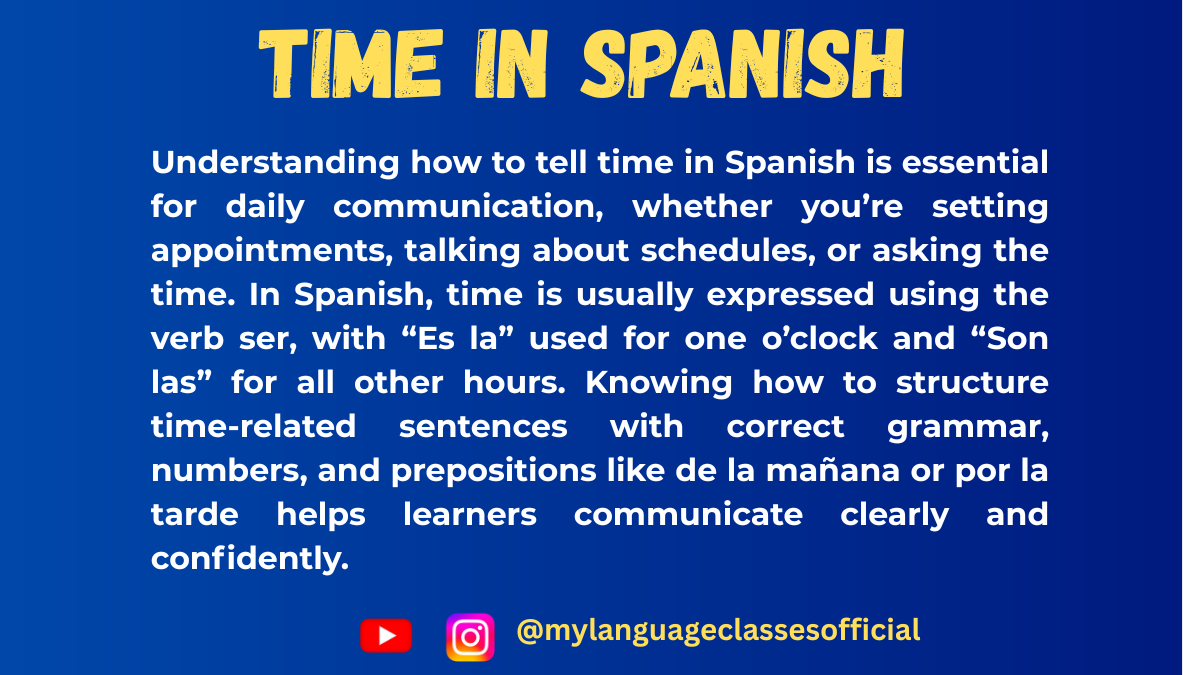Your cart is currently empty!
Tag: telling the time in Spanish
-

How to Ask and Tell Time in Spanish
Learning how to ask and tell the time in Spanish is one of the most practical and essential skills for Spanish learners. Not only will it help you in everyday conversations, but it also introduces you to key grammar concepts like articles, singular/plural forms, and verb usage.
In this blog post, we’ll break everything down step-by-step, so you can confidently talk about time like a native speaker.
1. Asking for the Time in Spanish
If you want to know what time it is, the most common way to ask is:
- ¿Qué hora es? (What time is it?)
This phrase is simple and polite, and it works in any situation.
If you want to ask someone more directly, you can say:- ¿Me puedes decir la hora, por favor? (Can you tell me the time, please?)
- ¿Tiene(s) la hora? (Do you have the time?)
💡 Note: Use tiene in formal settings and tienes with friends or peers.
2. Telling the Time in Spanish
Now that you’ve been asked the time, here’s how you respond:
Basic Structure
To tell the time in Spanish, you start with:
- Es la… → for 1 o’clock (singular hour).
- Son las… → for all other hours (plural).
For example:
- Es la una. → It’s 1:00.
- Son las dos. → It’s 2:00.
Adding Minutes
When adding minutes, use the following words:
- y → for “and” (used for minutes up to 30).
- menos → for subtracting minutes (used after 30 minutes).
Examples:
- It’s 3:15 → Son las tres y quince / Son las tres y cuarto (a quarter past three).
- It’s 4:30 → Son las cuatro y treinta / Son las cuatro y media (half past four).
- It’s 5:45 → Son las seis menos cuarto (a quarter to six).
On the Dot (Exact Time)
To say the time is exactly on the hour, add:
- en punto → “on the dot”
Example:
- Son las siete en punto. → It’s exactly 7:00.
3. Talking About AM and PM in Spanish
Spanish does not have a direct equivalent to AM and PM. Instead, time is expressed using specific phrases to indicate morning, afternoon, or evening:
- de la mañana → in the morning (AM)
- de la tarde → in the afternoon (PM, until evening)
- de la noche → at night (PM, after evening)
Examples:
- Es la una de la mañana. → It’s 1:00 in the morning.
- Son las tres de la tarde. → It’s 3:00 in the afternoon.
- Son las nueve de la noche. → It’s 9:00 at night.
Pro Tip: If you are speaking generally without specifying AM/PM, you can say por la mañana, por la tarde, or por la noche.
4. Key Grammar Rules for Telling Time
Definite Articles (La and Las)
In Spanish, time is feminine because it refers to the phrase “la hora” (the hour). This is why we use la (singular) and las (plural) with time.
- Es la una. → La for singular (1:00).
- Son las cinco. → Las for plural hours (2 and beyond).
Singular and Plural Usage
- Use es (is) with 1:00, as it refers to a single hour.
- Use son (are) with all other times, as they involve multiple hours.
Examples:
- Es la una. → It’s 1:00.
- Son las dos. → It’s 2:00.
5. Military Time (24-Hour Clock)
Spanish-speaking countries often use the 24-hour clock, especially for schedules like train or bus timetables.
- 14:00 → Son las dos de la tarde. (2:00 PM)
- 20:30 → Son las ocho y media de la noche. (8:30 PM)
If you’re not used to it, just subtract 12 from any hour after 12:00.
6. Common Expressions and Phrases
To sound more natural when talking about time, here are some useful phrases:
- ¿A qué hora…? → At what time…?
- Example: ¿A qué hora es la reunión? → What time is the meeting?
- La clase es a las cinco. → The class is at 5:00.
- Llegamos tarde. → We’re late.
- Es temprano. → It’s early.
7. Practice Makes Perfect
Here’s a quick exercise for you! Try to answer the following questions:
- ¿Qué hora es? (It’s 1:15.)
- ¿A qué hora comes? (Answer: I eat at 12:30 PM.)
- ¿Qué hora es? (It’s 7:45 PM.)
Answers:
- Es la una y cuarto.
- Como a las doce y media de la tarde.
- Son las ocho menos cuarto de la noche.
Conclusion
Understanding how to ask and tell time in Spanish involves learning basic structures, articles, and the singular/plural distinction. By practicing these rules and incorporating common phrases into your conversations, you’ll sound like a native speaker in no time.
Now, ¿qué hora es?—start practicing with your friends and daily routines!
Did you find this blog post helpful? Let me know in the comments below, and share it with someone learning Spanish! 👇
If you enjoyed this lesson, be sure to check out more posts like this on my blog at My Language Classes. Don’t forget to subscribe my YouTube channel and follow me on Instagram for the latest language learning tips and lessons. Leave a comment below to share your thoughts, or ask any questions you have.
Happy learning! 😊
